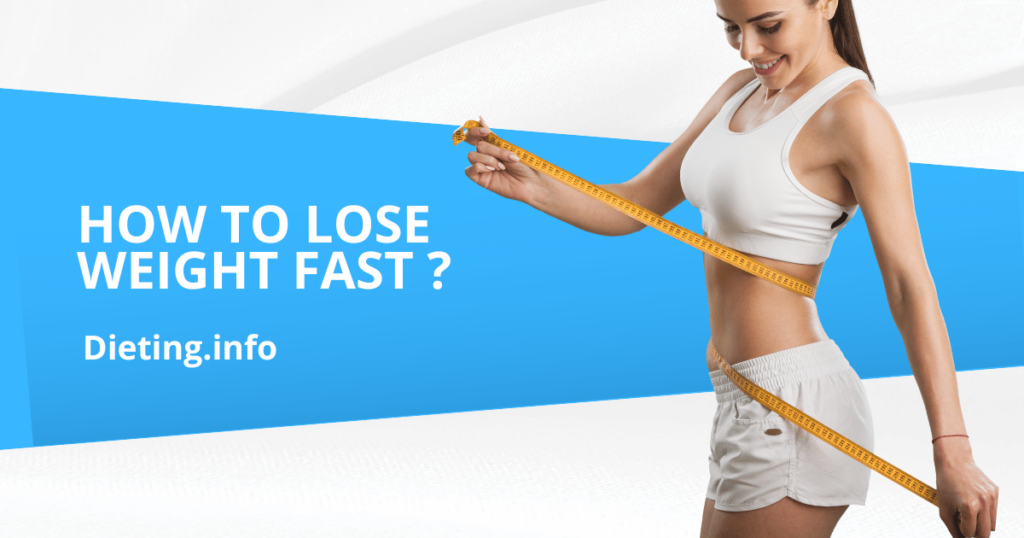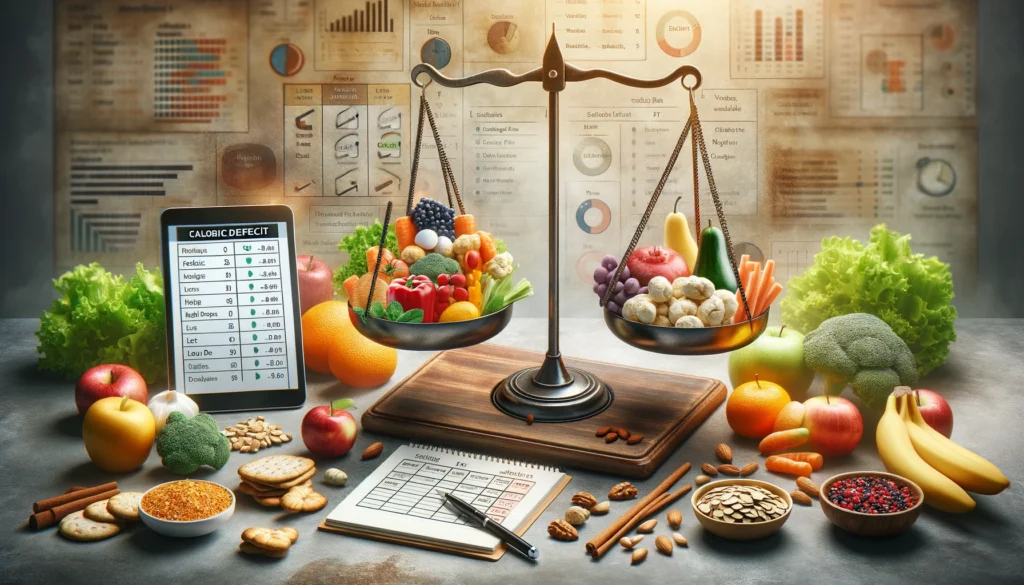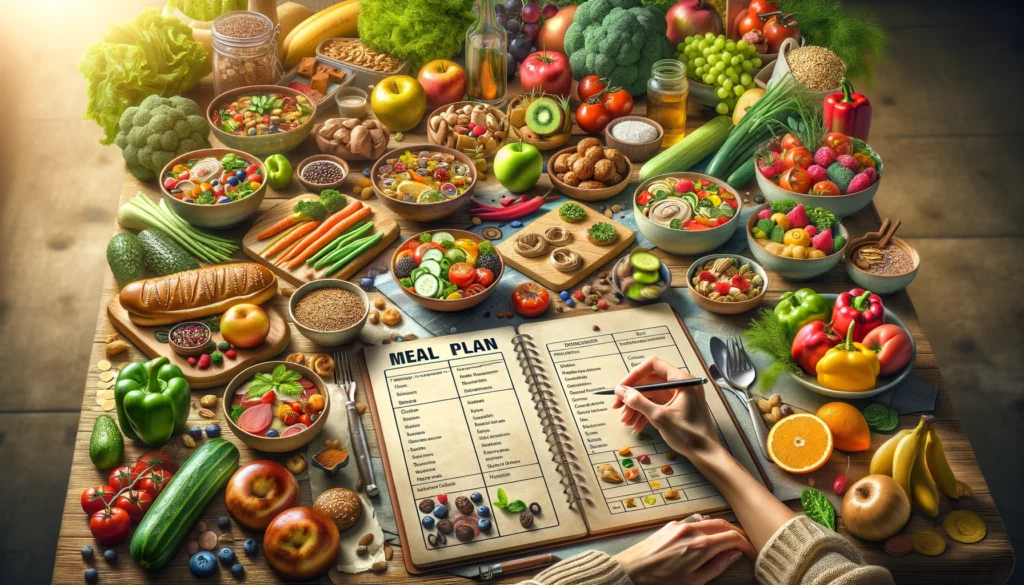
In a world brimming with quick-fix diet plans and promises of rapid weight loss, it’s crucial to approach how to lose weight fast with a blend of effectiveness, safety, and sustainability. While the allure of shedding pounds quickly is tempting, the key to enduring success is a balanced approach that incorporates healthy eating, regular physical activity, and lifestyle adjustments. This guide delves into the essential strategies for losing weight quickly, underlining the importance of doing so in a healthy and sustainable manner.
How to Lose Weight Fast
Before diving into the weight loss strategies, it’s important to understand the basics. Weight loss occurs when you consistently consume fewer calories than you burn. The deficit triggers your body to utilize stored fat for energy, leading to weight loss. While this concept sounds simple, the execution requires a thoughtful approach that encompasses diet, exercise, and behavioral changes.
Setting Realistic Goals
Start with setting achievable and realistic weight loss goals. Rapid weight loss can be motivating, but aiming to lose 1-2 pounds per week is considered safe and more sustainable in the long run. Fast weight loss exceeding this can lead to muscle loss, nutritional deficiencies, and other health issues.
Nutritional Strategies for Quick Weight Loss

Caloric Deficit with Nutrition
Creating a caloric deficit with nutrition is a fundamental approach to weight loss and involves consuming fewer calories than your body expends. This deficit forces the body to use stored fat for energy, leading to weight loss. Here’s how you can achieve this effectively while maintaining good nutrition
A general guideline is to create a deficit of 500-1000 calories per day to lose about 1-2 pounds per week. However, it’s important not to go too low, as extremely low-calorie diets can lead to malnutrition, muscle loss, and other health issues.
Portion Control
Portion control is a key strategy for weight loss, focusing on regulating the amount of food you eat to ensure that you’re consuming fewer calories than you burn, without necessarily changing what you eat. This approach can help create a caloric deficit, which is essential for weight loss, as it requires the body to use stored fat for energy, leading to weight loss over time.
Portion control is a key strategy for weight loss, focusing on regulating the amount of food you eat to ensure that you’re consuming fewer calories than you burn, without necessarily changing what you eat. This approach can help create a caloric deficit, which is essential for weight loss, as it requires the body to use stored fat for energy, leading to weight loss over time.
Here’s how portion control can aid in weight loss:
- Reduces Calorie Intake: By controlling your portions, you naturally consume fewer calories. Even healthy foods can contribute to weight gain if eaten in large quantities.
- Encourages Mindful Eating: Paying attention to portion sizes can help you become more mindful of your eating habits, encouraging you to eat slowly and recognize when you’re full, which prevents overeating.
- Flexibility: Portion control doesn’t require eliminating certain foods or following strict dietary rules. Instead, it allows for a balanced approach to eating, making it easier to stick to in the long term.
- Improves Nutritional Balance: By focusing on portion sizes, you’re more likely to eat a variety of foods, ensuring a balanced intake of nutrients. This can contribute to overall health, in addition to supporting weight loss.
- Helps in Understanding Hunger and Fullness Cues: Regularly practicing portion control can enhance your awareness of hunger and fullness signals, helping you to avoid eating out of boredom or emotional reasons.
To implement portion control effectively, consider using smaller plates, checking serving sizes on food labels, being mindful of your hunger cues, and avoiding eating straight from large packages. Remember, while portion control is a valuable tool for weight loss, it’s also important to focus on the quality of the food you eat and to incorporate physical activity into your routine for optimal health and weight management.
Meal Timing and Frequency
The timing and frequency of your meals can also play a role in weight loss, although perhaps not as directly as calorie intake and portion control. Some believe that eating smaller, more frequent meals can help keep metabolism steady and reduce hunger, potentially leading to fewer calories consumed over the day. However, the most crucial factor is still the total caloric intake, regardless of how many meals you eat. Some people find success with intermittent fasting, which involves eating within a specific window of time each day, while others may prefer three standard meals or multiple small meals throughout the day. The key is to find a pattern that works for you and helps you maintain a caloric deficit.
Hydration
Hydration plays a crucial role in the process of weight loss and overall health management. Water is fundamental to every cell in your body and is essential for various physiological processes, including metabolism and digestion. When you’re well-hydrated, your body can efficiently metabolize fat, plus adequate hydration can enhance your body’s ability to burn calories. Drinking sufficient water can also help in suppressing appetite, often leading to a reduced calorie intake. Sometimes, the body can misinterpret dehydration as hunger, so staying hydrated might prevent unnecessary snacking or overeating. Moreover, consuming water before meals can create a sense of fullness, encouraging smaller portion sizes and reducing overall calorie intake.
7 Easy Training Exercises you can Integrate into Your Routine to Help Lose Weight Quickly

Embarking on a weight loss journey can often seem daunting, but incorporating simple and effective exercises into your routine can significantly enhance your progress. These seven easy training exercises are designed to kickstart your metabolism, burn calories, and accelerate your weight loss journey, all while being manageable enough for beginners and adaptable for all fitness levels.
1. Walking
One of the most underrated forms of exercise, walking is a fantastic way to begin your weight loss journey. It’s low-impact, accessible to all fitness levels, and can be done anywhere. A brisk 30-minute walk daily can help you burn calories, improve your cardiovascular health, and boost your metabolism. Over time, increase your pace and incorporate varied terrain to intensify your workouts.
2. Jumping Jacks
This full-body workout is not just for school gym classes. Jumping jacks elevate your heart rate, improve muscle endurance, and burn a significant number of calories. Aim for short bursts of high-intensity intervals, doing as many jumping jacks as you can for 30 seconds, followed by a 30-second rest, and repeat. It’s a fantastic way to get your heart pumping and start shedding those pounds.
3. Planks
Planks are a powerhouse exercise that targets your entire core, which is crucial for overall body strength and weight loss. They also engage your shoulders, arms, and glutes, providing a comprehensive workout. Start with 20-second holds, gradually increasing the duration as you get stronger. Consistency with planks can improve your posture, reduce back pain, and enhance your abdominal strength.
4. Squats
Squats are essential for a weight loss routine, focusing on the lower body and core muscles. They help in building muscle mass, which in turn accelerates your metabolism. Ensure proper form by keeping your feet shoulder-width apart and back straight as you lower your body. Start with three sets of 10 squats, adding more reps and sets as you progress.
5. Lunges
Lunges are excellent for targeting the thighs, buttocks, and core, promoting functional fitness and enhancing weight loss. They can be done anywhere and easily modified for different fitness levels. Focus on keeping your upper body straight and your knees aligned with your ankles as you step forward. Alternate legs and aim for 10 lunges on each side, increasing the count as you improve.
6. Push-ups
Push-ups are a classic exercise that engages almost every major muscle group in your body, including your chest, core, and triceps. They’re incredibly efficient in building strength and boosting metabolism. If standard push-ups are challenging at first, start with knee or wall push-ups and gradually work your way up.
7. High Knees
High knees are a cardio-intensive exercise that helps burn calories fast, improve your agility, and increase your heart rate. They can be a fun addition to your workout, especially when mixed with other exercises. Try doing high knees for 30 seconds, rest, and then repeat. It’s a simple yet effective workout to enhance your weight loss efforts.
Incorporating the Exercises
Consistency is key when it comes to weight loss. Aim to incorporate these exercises into a daily routine, gradually increasing intensity and duration as your fitness level improves. Remember, it’s also essential to combine these exercises with a balanced diet and adequate hydration for optimal results. Always consult with a healthcare provider or fitness professional before starting any new workout regimen, especially if you have any health concerns or conditions.
With these seven easy training exercises, you’re not just stepping into a routine that promotes quick weight loss; you’re embarking on a journey toward a healthier, more active lifestyle. Start slow, stay consistent, and watch as your body begins to transform, shedding weight and gaining strength, flexibility, and endurance.
Lifestyle Modifications for Sustainable Weight Loss

Sleep and Stress Management
Adequate sleep and stress management are often overlooked aspects of weight loss. Poor sleep and high stress can increase cravings for unhealthy foods, leading to weight gain. Aim for 7-9 hours of quality sleep per night and employ stress-reduction techniques such as meditation, yoga, or deep breathing.
Consistency and Patience
Weight loss is a marathon, not a sprint. Consistent adherence to your diet and exercise plan is crucial for effective and sustainable weight loss. Be patient with yourself and recognize that progress takes time.
Support and Accountability
Having a support system can greatly enhance your weight loss journey. Whether it’s friends, family, or a weight loss group, surrounding yourself with like-minded individuals can provide motivation, advice, and accountability.
Avoiding Quick Fixes and Fad Diets
Beware of diets that promise miraculous results with minimal effort. These are often overly restrictive, nutritionally unbalanced, and unsustainable. While they might offer quick results, the weight is likely to return once you resume normal eating patterns.
A Holistic Approach to Rapid Weight Loss
Losing weight fast is a common goal, but it’s important to approach it wisely. A balanced diet, regular physical activity, and healthy lifestyle choices are the keys to successful and sustained weight loss. Remember, quick weight loss should still be gradual to ensure its sustainable and healthy. By adopting these comprehensive strategies, you can achieve your weight loss goals, improve your health, and maintain these benefits long-term. Always consider consulting with a healthcare professional
Sample Diet Plan for Fast Weight Loss

Breakfast
- Omelet made with two eggs, spinach, mushrooms, and a sprinkle of feta cheese.
- A cup of green tea or black coffee (without sugar or cream).
Mid-Morning Snack
- A small bowl of berries or a single piece of fruit (like an apple or pear).
- A handful of almonds or walnuts.
Lunch
- Grilled chicken or fish salad with a variety of colorful vegetables, dressed with lemon juice and olive oil.
- A side of quinoa or a slice of whole-grain bread.
Afternoon Snack
- Greek yogurt with a sprinkle of chia seeds and a few slices of kiwi.
- Vegetable sticks (carrots, cucumber, celery) with hummus.
Dinner
- Baked salmon or tofu stir-fry with a mix of bell peppers, broccoli, and snap peas.
- A side of roasted sweet potatoes or a small serving of brown rice.
Evening Snack (If Needed)
- A small serving of cottage cheese with cinnamon.
- A cup of herbal tea or broth.
Key Guidelines for Success
- Portion Control: Be mindful of portion sizes to avoid overeating, even of healthy foods.
- Limit Added Sugars and Refined Carbs: Cut down on foods high in added sugars and refined carbohydrates, such as sweets, baked goods, and sugary beverages.
- Regular Meals: Eating at regular intervals can help regulate blood sugar levels and manage hunger.
- Adapt and Customize: Tailor your diet to your personal preferences, dietary needs, and lifestyle to ensure it’s sustainable and enjoyable.
A Few Things to Note
- Rapid weight loss diets can be effective but may not always be sustainable or healthy in the long term. Aim for a balanced approach that you can maintain even after reaching your weight loss goal.
- Always consider consulting with a healthcare provider or a dietitian before starting any fast weight loss diet, especially if you have any underlying health conditions or are taking medication.
- Remember, the best diet for fast weight loss is one that promotes a healthy relationship with food, includes a variety of nutrients, and fits your individual lifestyle and preferences.